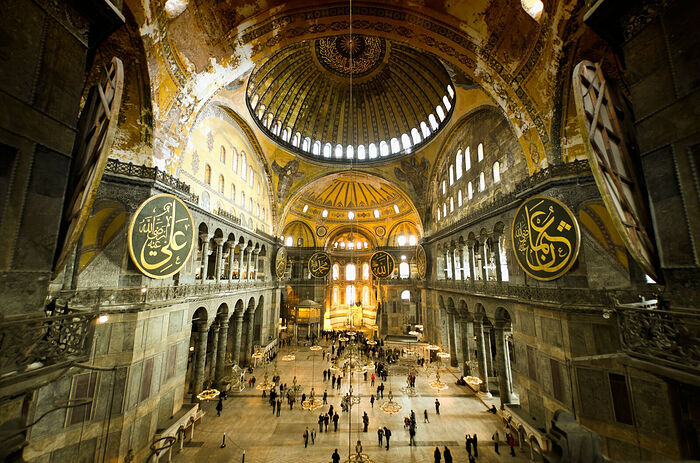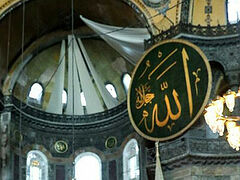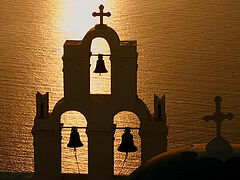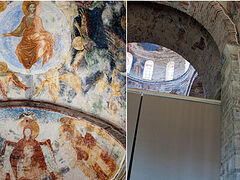Hagia Sophia is to be converted to a mosque. The whole Christian world (diverting its attention momentarily from fear of the coronavirus) is outraged; in many of those places where churches are actually open, prayers are being said that the Turkish authorities may reverse this decision. The Pope is ‘pained’. Even the World Council of Churches, finding a limit to their ecumenistic tolerance, have wagged a collective finger. One would think that the infidels were locking some Christian congregation out of their basilica and forbidding them to sing!
Certainly, one cannot rejoice over the re-masjidification of a place that, a millennium ago seemed more in heaven than on earth. But the Church of the Holy Wisdom has been desecrated many times since and had been desecrated before. The new mosque’s managers are unlikely to place a harlot on the patriarchal throne, as happened when the drunken thugs of the Fourth Crusade rampaged through the city; instead, they are requiring visitors to remove their shoes as they tread on holy ground. If the dome will now once again resound with Muslim prayers as it did for five centuries, it has resounded with alien prayer before: not only with the prayers of Roman Catholics, but with those of monothelites and unionists. The icons will merely be covered for part of the day by curtains, but even if they should again be whitewashed, it must be remembered that the cathedral endured two earlier waves of Christian iconoclasm, backed by emperors and patriarchs.
Was Ataturk’s conversion of the mosque into a museum also a desecration? Surely it was as offensive to Muslims of the time as, say, the closure of a great Orthodox cathedral by state authority would be to Christians now. (Of course, such an event cannot be imagined!)
Muslims have a long history of re-purposing the edifices of other religions. The Kaaba itself was, from the somewhat limited geographical perspective of the Companions of the Prophet, the greatest pagan temple in the world (and one that contained in its god-collection an ikon of the Virgin and Child, the only ‘idol’ spared, for a time, by the zealots of the new faith). The Temple in Jerusalem was long gone when the Arab conquerors arrived, but they claimed the space with their Dome of the Rock. Countless Muslim warlords have dreamt (and dream still) of being the fulfiller of prophecy who recites verses from the Koran at the high altar of St. Peter’s.
Why do the triumphant Knights of Islam sometimes re-use the sanctuaries of other faiths, instead of destroying them as they did the Buddhas of Bamyan? No doubt to some extent from practicality: unlike giant Bodhisattva figures, giant domes are easily converted from the service of one religious system to that of another, with excellent financial savings. But there is a theological basis as well, which may be caricatured as a set of four propositions. They believe:
1. That (their) God exists, and is the source of all values;
2. That the goal of human life is the worship of (their) God;
3. That adherents of religions other than theirs are worshipping the wrong God, or at best worshipping the true God wrongly;
4. That all the arts, sciences, achievements, buildings and so forth of societies practicing other religions should be repurposed to the glory of (their) God, either to show that (their) God has triumphed or, more generously, to fulfil the misguided but well-meaning pious intentions of the original creators.
From an Orthodox Christian perspective, it seems to me, the only problem with these four propositions is the word ‘their’ and its derivatives. Replace the word with ‘our Triune’, and what error can be found in them? Did not St. Basil call us, too, to be bees in the meadows of alien culture? Was not the Parthenon made into a church... But I run too quickly.
On the other hand, what messages were the overtly secular and anti-Islamic rulers of twentieth century Turkey trying to send when (at the suggestion of American archaeologists with a somewhat more complex agenda) they converted Hagia Sophia from a mosque into a museum?
1. That universal human (in practice, Western) culture is the source of all values;
2. That the goal of human life is service to the nation (or some other aspect of secular society, perhaps even service to humanity as a whole);
3. That religions are social phenomena, components (perhaps but not necessarily valuable ones) of national or broader human history;
4. That artistically or historically significant religious buildings are part of a nation’s (or humankind’s) heritage, not simply the property of a particular religion, and can be appreciated for their beauty, for their significance in the growth of the nation or the March of Progress, and so on.
In the 1900s, this attitude was part of the Westernizing Turkish nationalism that led Ataturk to replace the fez with the homburg as the national hat. Today, Turkish nationalists are more likely fervent Muslims, but the museumisers’ message still flourishes outside Turkey. Thus, Hagia Sophia is (undisputedly) an artistic, architectural, and technological masterpiece; it was the setting of major events in the history of global civilisation (including religious events such as the conversion of Vladimir’s emissaries and the Schism of 1054); it is a symbol of the multi-ethnic, multicultural empires of Byzantium and the Ottomans. It is a place where visitors from around Turkey can admire the glories of their country’s past, while others from around the world can feel uplifted by the surprising capacity of human beings to construct a whopping big dome without benefit of computers, calculus, or even steam power. In the revealing words of Abbot Bartholomew of Esphigmenou, ‘It is a global destination, above religions and peoples, a universal cultural heritage, a global symbol of unity. This unity is the answer for all of us to every movement of nationalism and fanaticism.’1 [Emphasis added.]
Of course, it is also a place where Greeks can wax nostalgic about lost empires, and Turks can do the same. The latter aspects, more than Muslim piety, is doubtless the largest factor in the current re-conversion plans. This makes Hagia Sophia a politically valuable place for men like Mr. Erdogan, and a dangerous place for the world. It is hardly impossible that war will erupt as a (probably indirect) result of Turkey’s decision.
What is the appropriate Orthodox Christian response? Wringing one’s hands? Howling with exaggerated grief and anger? Writing a note of protest to the Turkish embassy? ‘Discontinuing the restoration of the Valide mosque in Mytilene?’ (That’ll show ’em! Eye for an eye!) Mobilising the Hellenic Navy?
Or: Praying for the conversion of Turkey, so that Hagia Sophia can someday be an Orthodox church with an Orthodox congregation? Evangelizing Muslims everywhere? Re-opening churches that have flesh-and-blood, modern parishioners? Making those existing churches so spiritually beautiful that visitors will not know if they are on earth or in heaven? Abandoning the more-than-papist ideology and the paradoxical combination of phyletism and ecumenism currently dominant in the Fener?
Or even: Emulating the infidels’ example?
Once upon a time, in the Acropolis of Athens, there was a magnificent Orthodox church overlooking the city. It had been a (relatively minor) Pagan temple for eight centuries, dedicated to Athene Parthenos. With the coming of Christianity, it was rededicated to the Theotokos ‘Atheniotissa’, the Athenian. The site of a miraculous ‘inextinguishable light’ and holding the relics of St. Macarius the Great, it was one of the chief pilgrimage destinations of the East Roman world. Eight centuries passed; the Empire fell. The church was Roman Catholic for a while, then Orthodox again. The Turks (who had restored the church to the Orthodox) later changed it into a mosque, and then, unwisely, into a powder magazine during the Venetian siege. For unclear reasons, the post-explosion ruins came to represent the Glory That Was Greece (meaning Pagan, classical Greece) to generations of antiquarians in Northern Europe, and, therefore, to represent the dream of renewed national greatness to the citizens of the Hellenic Republic. (For those interested, the Christian history of the Parthenon has been exhaustively researched by Prof. Anthony Kaldellis, whose writings on the subject are widely available in English.)
The appearance of this great church has been reconstructed by scholars. Some striking images may be viewed here.
(These depictions include the asymmetrically placed bell-tower, which was added during the Latin occupation and later used a minaret by the Turks, but otherwise show the temple exterior very much as it would have appeared to the East Romans.) As Prof. Kaldellis has pointed out, this history (even the Roman Catholic part) has to a large extent been intentionally censored, in the interest of secular myth-making about the ‘Dark Ages’. The extensive restoration work conducted on the Acropolis has been aimed almost entirely at evoking the Periclean era. Some carvings of a drunken brawl between centaurs and Lapiths, prominently displayed in the British Museum since 1816, have for decades been the cause of endless popular agitation and governmental chest-pounding, but the Christian antiquities of the Parthenon attract almost no interest whatever.
I propose that we Orthodox should emulate the Turkish Muslims and begin a campaign for the restoration of the Parthenon as a cathedral. The restoration should of course respect the pagan origins of the building—those Classical era mythological carvings not already moved to museums in Athens, London, or elsewhere should remain. Visitors and tourists should be welcome (except, obviously, in the restored apse). Archaeology, too, should continue (perhaps with a less exclusive focus on the Classical and pre-Classical periods, however). But the building should cease to be a ruin and should once again become a working church.
The Parthenon is one of the most famous structures in the world, and (although this would have surprised Plato and his contemporaries) has become the pre-eminent symbol of all that is best in both the Hellenic and broader Western cultural traditions. By reviving the Parthenon as an Orthodox cathedral, the Church could signal to all that Orthodoxy is the universal faith, the faith that encompasses everything that is good, true, and beautiful. The existence of such a cathedral would testify that the idols have been overthrown—not so much Phidias’s long-lost statue of Athene as the idols of secular arrogance. At the national level, it would demonstrate both the continuity of Greek culture and the radical transformation brought by the Gospel. Located in the heart of an Orthodox Christian city, the Parthenon would be guaranteed a congregation (which Hagia Sophia will never have until the Turks convert). Who knows—perhaps God will even grant a miracle, such as the inextinguishable light of old.
May all the effort currently put into protesting the conversion of the Hagia Sophia Museum into a mosque be redirected into converting the Parthenon ruins into a cathedral, of COVID-emptied churches into places where visitors do not know if they are on earth or in heaven, of good Muslims into better Christians, and of our sinful hearts into temples of the Holy Wisdom.





